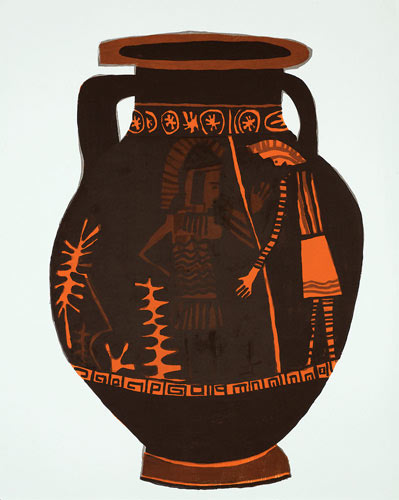
As George Santayana wrote, "Those who cannot remember the past are condemned to repeat it." That may be true in love and war but in art history it’s quite acceptable to learn and still repeat anyway. It’s called gaining inspiration, and Jonas Wood has apparently done just that after studying ancient Greek vessels and then, skipping ahead some centuries, channeled modernists like Henry Matisse and Alexander Calder.
Then again, he delves into what some see as the antithesis of the arts, namely sports. But, recognizing the commonality between making art and athletic prowess on one hand and the naïve devotion of fans, he has created a series of depictions of basketball stars in a naïf style. A multi-media artist, painter and printmaker, Wood renders subjects in a straightforward and yet unique style that does not aim toward virtuosity of line and color. In fact, one might reach the conclusion that Wood is anything but an accomplished draftsman and, perversely, that is exactly what makes his work outstanding.
By depicting a potted plant in an ancient Greek vase, he does away with the preciousness and, often, pretentiousness that accompanies ancient art and puts off the masses. Instead he reminds his audience that these are pots that might actually have been created for practical, if not necessarily domestic use, relics whose virtue in part lies in the blunt fact that they survived (in some form at least) centuries after their creators turned to dust.
The “Greek Vessels” are a series of untitled lithographic monoprints that depict the same scene, a plant growing out of a container decorated by the outline of three horses. By distributing dark and light hues throughout, Wood gives each an individual sense of geometry, space and visual appeal. Another series of six woodprints depicts a Greek vessel in grisaille or with a sparing addition of color. Here, even though the subject is ancient, Wood has given it a modern feel through his use of line and color.
His portrayals of basketball stars such as Kareem Abdul Jabbar bring to mind sport trading cards. Despite the initial appearance, the works are anything but naïve. They serve to question the god-like adulation sports figures elicit, instead inviting ruminations on the nature of seduction and, somewhat extrapolated perhaps, the power of commercial manipulation of both celebrities and the public.
A series of prints of basketballs is a direct homage to the Pop tradition — basketballs replace soup cans — and remind one of Warhol’s send-up of the overwrought exclamations over the meaning of art and, on the other hand, the potential of everyday objects as apt subject matter for art. And, if anyone is still looking for a connection between sports and art, all it takes is a look at the gazillions of dollars overly tall men receive for pitching a rubber globe through a hooped net and the overheated high end of the art market since the 1980s.
Since Warhol’s death, the vicissitudes of the art market seem to have perverted the artist’s intention of making art accessible to a mass audience. It’s accessible, perhaps too much so in terms of content, but unattainable to all but the few financially. Which leads one back to Wood and his sports subjects: They are accessible to the masses via electronic media but how many can actually afford to buy tickets?
Hence, if Wood’s work for this show (more formally complex paintings are omitted) appears straightforward and simple, it’s anything but simplistic, inviting viewers to look beyond the ostensible subject matter and ponder the purpose and access to art, be it of our own time or deeply historical.
Published courtesy of ArtSceneCal ©2010
